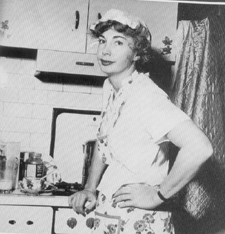|
|
In 1952 Gleason and his performers took to the road with four shows a week. At this time Alice was played by Pert Kelton. The grueling schedule took it's toll on her when one day after performing she collapsed. It turned out she had developed a heart condition. When Gleason returned to New York he was faced with finding a new alice. In September 1952 Jackie Gleason signed a new contract with CBS. This time around he would be solely responsible for his own hour long Saturday variety show. This time around he would have more control as far as ownership, production, hiring writers, performers, musicians and bringing an hour long Saturday who to the air. Best of all the show would be called, 'the Jackie Gleason show'. Jackie brought some people from his old show with him including Art Carney and Joyce Randolph. Jackie was now getting paid $7,500 a week plus if he brought the show in under budget ($120,000) CBS would split the difference (not to exceed $5,000). Art Carney was now getting $1,000 a week with 3 weeks out of 13 off for other acting opportunities. Joyce Randolph got a raise from $160.00 to $200.00 a week.
Gleason's first year with CBS drew in upwards of 60 million viewers. Rumor has it that more people stayed at home to watch Gleason then were on the roadways, in theatres, or at the supermarket. Gleason's insistance on not rehearsing had everyone on edge. He could read about 60 lines of the script on a Saturday morning and still know it by airtime. The cameraman had it the worst and most times needed direction as to where and what was happening at all times since Gleason never followed the script or his marks exactly. Jackie always felt that the first time he delivered a line was the funniest. Spontaneity seemed to work and no one ever noticed a missed line or cue unless a prop didn't work or a wall was knocked down. By January 1955 the Jackie Gleason show was no. 1 (with a 5.34 percent of homes) compared to I Love Lucy's 51.2 percent. By this time most American's knew who Ralph, Alice, Norton and Trixie were. Each Saturday people would start lining up at 11am for tickets to the show (which would begin at 8pm). At least 1,000+ tickets were given out for each show. Towards the fall of 1955 new contracts were signed ending 'the Jackie Gleason show' and giving new birth to 'the Honeymooners' and 'Stage Show'. Jackie had signed on with Buick to film 39 half-hour Honeymooners shows (for the 1955 tv season) that would be broadcast from 8:30 - 9:00pm Saturdays. The cast got raises; Gleason would get $65,000 per show, $32,500 per re-run (more money for years to come), Carney was raised to $3,500 a week, Meadows to $2,000, and Randolph to $500 (only appeared in 3/4 of the episodes). Also, another contract Gleason signed stated he would get $100,000 annually for the following 15 years whether he worked for them or not. The contract became void if he signed on with a competing company. The Honeymooners now became TV's first spinoff (of a variety show). All 39 (classic) episodes were filmed with a new film system called "Electronicam". This was the closest to recapturing that "Live" look. The shows were filmed before a live audience (no canned laughter) in NYC on West Fifty Fourth Street at the Adelphia Theatre. Three cameras were used; one on each side and one stationed on a ramp that reached out from the center of the stage and a third of the way into the orchestra. About a thousand audience members laughed each week to Gleason and his co-horts' antics and scwabbles. Each show took forty minutes to film with a break in the middle to change film. Once each show was filmed from the three cameras it would be edited and combined for a half hour broadcast. Note: History of the Honeymooners compiled by Brother Norton from various sources including The Honeymooners Companion (by Donna McCrohan) |


 Audrey
Meadows landed the part of Alice after Pert Kelton left the show.
Legend has it that when Jackie was presented with the name Audrey
Meadows he wouldn't even consider her as Alice. Audrey Meadows had
photos taken first thing in the morning before putting on makeup, fixing
her hair, or taking a shower. When Gleason saw the photos she
immediately got the part.
Audrey
Meadows landed the part of Alice after Pert Kelton left the show.
Legend has it that when Jackie was presented with the name Audrey
Meadows he wouldn't even consider her as Alice. Audrey Meadows had
photos taken first thing in the morning before putting on makeup, fixing
her hair, or taking a shower. When Gleason saw the photos she
immediately got the part.